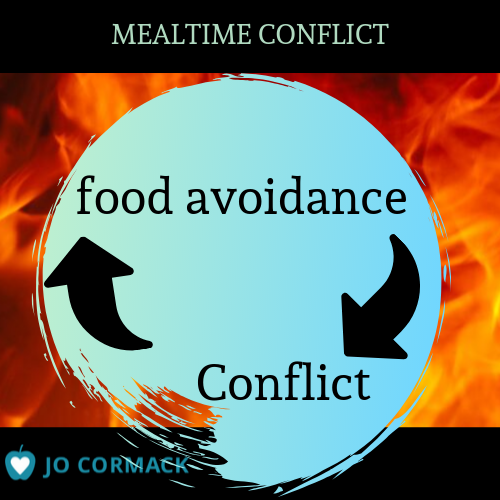Mealtime Peace 💙
There are SO many things feeding professionals need to consider when working with a family… is the child’s nutritional status a worry? Do they need some help with their chewing skills? Have they got any digestive issues? Do they have sensory processing challenges? Feeding is a jigsaw puzzle with many pieces.
However, while we might work on factors like these with the appropriate professional, it is impossible for a family to move forward without ‘mealtime peace’. This is a phrase coined by one of the leading experts in child feeding, Marsha Dunn Klein. Marsha writes:
“To find mealtime peace, we ask parents to step back and consider what would it take to have a peaceful mealtime for your family or what would you need to do to find mealtime peace today, now? Can you imagine what a mealtime would look like with no stress, no anger, no pressure, no take a bite?”
(Dunn Klein, 2019, p.132)*
When I think about mealtime peace, I am reminded of the research into how conflict affects eating. We know that conflict makes eating worse**. We also know that moderate levels of avoidant eating make conflict about three times more likely, with severe avoidant eating making it five times more likely***. So here we have a vicious circle: The less peaceful the mealtime, the greater the likelihood of feeding problems. The more feeding problems there are, the greater the chance of mealtime conflict!
Children’s temperament is relevant too – we know that children with an emotional temperament are more likely to struggle with eating. it is easy to imagine that these same children are more likely to get pulled into mealtime conflicts simply because they get upset more quickly and easily than other children; it takes less to provoke an emotional reaction.
And then there is everything that WE (metaphorically) bring to the table as adults. Feeding is relational. It is about the child AND the adult. So while factors like your child’s temperament can contribute to mealtime conflict, so can your stress levels. And so can disagreements between you and other adults, about how to tackle ‘picky eating’. When you and your partner (or your mother in law!) have different ideas about how to feed your child, this can cause enormous tension.
How to achieve mealtime peace
- Have another look at the questions Marsha Dunn Klein poses in the quote above. What would your answers be?
- Are you clear HOW to avoid mealtime pressure and what a positive, responsive approach to mealtimes looks like? If not, here are a few resources for you to explore:
Anxious Eaters, Anxious Mealtimes – Marsha Dunn Klein
Helping your child with extreme picky eating – Katja Rowell and Jenny McGlothlin
Parenting Picky Eaters (facebook group)
Mealtime Hostage (facebook group)
Your Feeding Team (membership site)
- Have you done everything you can to get on the same page as your partner or other adults who are present at mealtimes? If you are unsure where to begin with this, look out for my next two posts, which will be all about working with others (OR damage limitation, if it comes to that).
Mealtime peace is the fertile ground that any other feeding intervention needs, in order to set seed and flourish. There are no tips, tricks or secret strategies that will help your child build their eating confidence – responsive feeding (where you are attuned to your child and you don’t push or pressure them to eat) is the only way.
What one thing can you do now, today – to move a step closer to mealtime peace?
* Dunn Klein, M. (2019) Anxious Eaters, Anxious Mealtimes: Practical and Compassionate Strategies for Mealtime Peace, Archway Publishing, IN
** Carruth, B. Skinner, J., Houck, K., Moran III, J., Coletta, F., & Ott, D. (1998). The phenomenon of “picky eater”: a behavioral marker in eating patterns of toddlers. Journal of the American College of Nutrition, 17(2), 180-186.
***1. Zucker, N., Copeland, W., Franz, L., Carpenter, K., Keeling, L., Angold, A., & Egger, H. (2015). Psychological and psychosocial impairment in preschoolers with selective eating. Pediatrics, 136(3), e582-e590.

